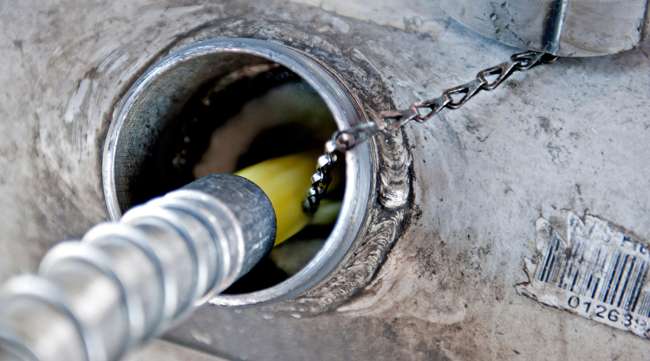Senior Reporter
Diesel Climbs 4¢ to $2.502 Amid Stronger Demand

[Stay on top of transportation news: Get TTNews in your inbox.]
After declining for much of the spring and summer, the fall is proving to be a more robust season for diesel demand nationwide.
The U.S. Energy Information Administration reported Nov. 30 in its weekly survey that trucking’s primary fuel increased 4 cents nationwide and now costs $2.502 a gallon.
The price has risen each week in November.
U.S. average on-highway #diesel fuel price on 11/03/2020 was $2.502/gal, UP 4¢/gallon from 11/23/2020, DOWN 56.8¢/gallon from year ago https://t.co/5HyjAzUGlp #truckers #shippers #fuelprices pic.twitter.com/7YZmQBU7Yf — EIA (@EIAgov) December 1, 2020
But even with the rise, diesel is 56.8 cents less expensive than it was a year ago. Much of the price decrease took place during the first half of 2020 when demand plummeted because the coronavirus pandemic led to mandates to stay home.
Gasoline also rose in nine of the 10 regions surveyed by the EIA. Gasoline increased 1.8 cents per gallon to $2.12 a gallon nationwide, compared with $2.102 the week before.
Still, unleaded gasoline is 45.5 cents less expensive than it was a year ago.
U.S. average price for regular-grade #gasoline on 11/30/2020 was $2.120/gal, UP 1.8¢/gallon from 11/23/2020, DOWN 45.5¢/gallon from year ago https://t.co/IAXagfQlSL #gasprices pic.twitter.com/qAlW9jU2Vy — EIA (@EIAgov) December 1, 2020
The only area where unleaded gasoline declined was the West Coast region, excluding California, where the price dipped two-tenths of a cent to $2.463 from $2.465 the previous week.
Diesel rose in all 10 regions in EIA’s survey — ranging from a low of 1.7 cents per gallon in the New England region (to $2.575) to 4.5 cents per gallon in the Midwest (to $2.404). In New England, diesel is 50.3 cents less expensive per gallon than a year ago, and in the Midwest, it is 57.8 cents lower.
The most expensive diesel in the country remains in California, where the price increased by 3.5 cents per gallon to $3.288. Diesel there is 67.2 cents less costly than it was a year ago.
The least expensive diesel remains in the Gulf Coast region, which is home to much of the nation’s oil production and refining capability. There, diesel rose 4.4 cents per gallon to $2.254. In that region, diesel is 52.5 cents per gallon less expensive than it was a year ago.
The increase in diesel and gasoline prices is being sparked by a jump in oil prices on world markets. West Texas Intermediate crude, the industry’s benchmark, closed Dec. 1 at $44.55 a barrel, which is up nearly $8 a barrel from its close of $36.81 on Nov. 2. Even with the recent increase, the price of oil is still down 90 cents a barrel from the recent high of $45.71 on Nov 25.

Kloza
Oil Price Information Service founder Tom Kloza said some of the increase in oil may be related to optimism about the world economy because of hopes of a COVID-19 vaccine being widely available for the general public in the spring and summer of 2021.
“I think the rally in oil November 20 through the 24th was a bit of a placebo. November was an up month for crude oil, diesel and jet fuel,” Kloza said. “Almost everyone in the investment banking industry is being bullish about the second half of 2021, but the first half of the year, it could be ugly because of COVID. I think we’re going to go through some pain economically, and that’s in the first quarter of the year.”
Meanwhile, according to the EIA, domestic oil production is creeping back up, but it’s still nowhere near the pre-pandemic level in 2019 when U.S. wells were producing nearly 13 million barrels of oil daily.
How did turkey-to-table change this year? What obstacles were suppliers going through to get turkeys to grocery stores? Join us as we talk with J.J. Smith, President of Valley Proteins, about how staying open-minded and flexible helped his business of delivering turkeys persevere. Hear a snippet, above, and get the full program by going to RoadSigns.TTNews.com.
In September, domestic production reached 10.86 million barrels per day on average, the EIA said Nov. 30. However, September’s oil production was up 2.6% from 10.57 million barrels per day in August.
Even with the increase, year-over-year production is still down 13.1% when measured against the same period in 2019.
Much of the increase in oil production came from the Gulf of Mexico, which is returning to normal after an above average hurricane season, which caused energy-producing platforms to be evacuated numerous times to get workers ashore.
Gulf oil production is still down when measured against 2019 figures, as wells produced 1.51 million barrels per day in September, compared with nearly 1.92 million barrels per day in 2019. But month-over-month oil production was up 315,000 barrels per day in the aftermath of the high hurricane activity.

Home | Video | Heroes' Photo Gallery
Saluting the men and women of the trucking industry who kept America's essential goods flowing during the coronavirus pandemic.
Heroes: Peter Lacoste | Susan Dawson | James Rogers | Reggie Barrows | Kevin Cooper | Cesar Quintana Moreno
Texas continues to be battered by the COVID-19 pandemic.
The oil production slump in oil-rich Texas worsened in September as the state produced the lowest amount of oil in more than 18 months.
According to the Texas Railroad Commission, the state agency in Austin that regulates energy production, oil production in September fell 21.2% year-over-year to 4.09 million barrels per day, compared with 5.19 million barrels per day in the same month a year ago.
Want more news? Listen to today's daily briefing:
Subscribe: Apple Podcasts | Spotify | Amazon Alexa | Google Assistant | More





